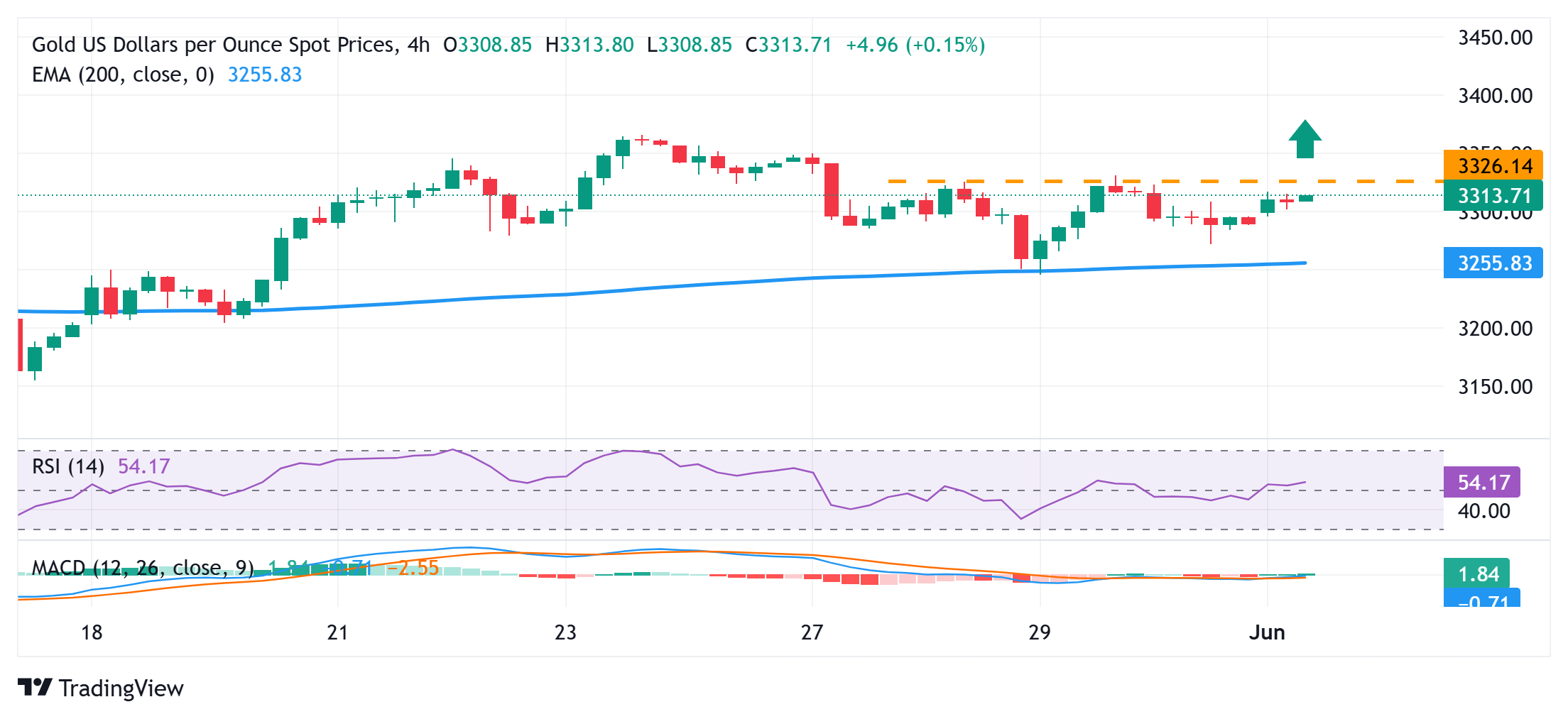- Gold price attract fresh buyers on Monday amid modest USD weakness.
- US fiscal concerns and Fed rate cut bets keep the USD bulls on the defensive.
- Trade uncertainties and geopolitical risks further benefit the XAU/USD pair.
Gold price (XAU/USD) builds on its steady Asian session move higher and touches a fresh daily peak, around the $3,317 region in the last hour amid a combination of supporting factors. The US Dollar (USD) drifts lower in the wake of rising bets that the Federal Reserve (Fed) will cut interest rates further, bolstered by softer inflation data released on Friday. This, along with US fiscal concerns, weighs on the USD, which, in turn, acts as a tailwind for the commodity.
Meanwhile, persistent geopolitical risks stemming from the protracted Russia-Ukraine war and conflicts in the Middle East, along with renewed US-China trade tensions, temper investors’ appetite for riskier assets. This turns out to be another factor underpinning demand for the safe-haven Gold price. With the latest leg up, the XAU/USD has now reversed Friday’s modest losses and the supportive fundamental backdrop supports prospects for a further appreciating move.
Daily Digest Market Movers: Gold price is underpinned by a broadly weaker USD and the flight to safety
- The US Bureau of Economic Analysis reported on Friday that the Personal Consumption Expenditures (PCE) Price Index cooled to the 2.1% YoY rate in April, or the lowest since February 2021. Meanwhile, the core PCE Price Index, which excludes volatile food and energy prices, came in at 2.5%, down from the 2.7% increase registered in March.
- Traders continued to bet that the Federal Reserve will lower borrowing costs in September and are pricing in the possibility of another rate cut in December. Fed Governor Christopher Waller said on Monday that rate cuts remain possible later this year even with the Trump administration’s tariffs likely to push up price pressures temporarily.
- Investors now await speeches from several FOMC members this week, including Fed Chair Jerome Powell’s appearance later this Monday, for cues on the monetary policy outlook. This will play a key role in influencing the near-term US Dollar price dynamics and determining the next leg of a directional move for the non-yielding Gold price.
- Ukraine ramped up the war with one of the biggest drones attracted to Russia ahead of the second round of direct peace talks in Istanbul later today. Ukraine conducted major drone strikes against Russian military airfields across five regions on Sunday and hit over 40 Russian military aircraft, which included nuclear-capable long-range bombers.
- Israel strongly denied its involvement in the deadly incident that claimed at least 30 Palestinian lives and accused Hamas of firing on hungry civilians gathered to receive humanitarian aid in southern Gaza. This comes amid a flurry of conflicting reports and keeps geopolitical risks in play, further lending support to the safe-haven XAU/USD.
- Traders now look forward to important US macro releases scheduled at the beginning of a new month, starting with the ISM Manufacturing PMI on Monday. Apart from this, Fed Chair Jerome Powell’s speech might influence the USD price dynamics and contribute to producing short-term trading opportunities around the commodity.
Gold price could accelerate the intraday move higher once the $3,326-3,328 immediate hurdle is cleared

From a technical perspective, the XAU/USD pair is likely to confront a stiff barrier near the $3,326-3,328 supply zone. Against the backdrop of last week’s bounce from the 200-period Exponential Moving Average (EMA) pivotal support on the 4-hour chart, a sustained strength beyond will be seen as a fresh trigger for bullish traders. The subsequent move up could lift the Gold price to the $3,345-3,350 intermediate resistance, above which the Gold price could aim to reclaim the $3,400 mark. The momentum could extend further towards the next relevant barrier near the $3,432-3,434 region.
On the flip side, weakness below the $3,300 round figure could find some support near the $3,280-3,278 zone. Any further slide could be seen as a buying opportunity and remain limited near the $3,258-3,257 region. The latter represents the 200-period EMA on the 4-hour chart, which if broken decisively could make the Gold price vulnerable to accelerate the fall further towards the $3,200 mark.
US-China Trade War FAQs
Generally speaking, a trade war is an economic conflict between two or more countries due to extreme protectionism on one end. It implies the creation of trade barriers, such as tariffs, which result in counter-barriers, escalating import costs, and hence the cost of living.
An economic conflict between the United States (US) and China began early in 2018, when President Donald Trump set trade barriers on China, claiming unfair commercial practices and intellectual property theft from the Asian giant. China took retaliatory action, imposing tariffs on multiple US goods, such as automobiles and soybeans. Tensions escalated until the two countries signed the US-China Phase One trade deal in January 2020. The agreement required structural reforms and other changes to China’s economic and trade regime and pretended to restore stability and trust between the two nations. However, the Coronavirus pandemic took the focus out of the conflict. Yet, it is worth mentioning that President Joe Biden, who took office after Trump, kept tariffs in place and even added some additional levies.
The return of Donald Trump to the White House as the 47th US President has sparked a fresh wave of tensions between the two countries. During the 2024 election campaign, Trump pledged to impose 60% tariffs on China once he returned to office, which he did on January 20, 2025. With Trump back, the US-China trade war is meant to resume where it was left, with tit-for-tat policies affecting the global economic landscape amid disruptions in global supply chains, resulting in a reduction in spending, particularly investment, and directly feeding into the Consumer Price Index inflation.

